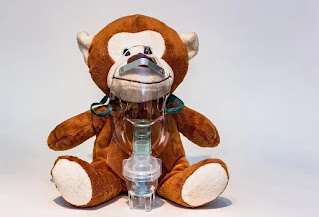What is OXYGEN saturation level?
And how to maintain it at normal?
Yeah, in today’s era when there is virus
all-around and a severe crisis of oxygen cylinders and oxygen beds in hospitals
they are the common questions. Here it will make a clear view of how to manage
when those conditions and how to prepare yourself to face it when in need. May
this article help all those out there with the new words like- SpO2 ,
oxygen saturation, proning, hypoxemia, pulse oximeter, nebulizer and many more.
So first of all, what is the oxygen
saturation level actually?
Oxygen saturation level is basically, the
fraction or ratio of oxygen saturated haemoglobin to the total haemoglobin that
is saturated as well as unsaturated.
Here are the ranges to get an idea:
·
Normal SpO2 –
94-100%
·
When, SpO2 less than
92 or 90; then it is dangerous.
·
Person suffering from COVID-19
can have less than 94% is severe condition.
Why does low levels of oxygen leads to death?
The big question is this. Last year too there was corona but the second
wave of COVID-19 is far more dangerous and is capable of infecting the
respiratory tract at much faster rate. This fast infection leads to inability
of lungs to inhale oxygen and transport it to various cells and tissues. And
hence the saturation level of oxygen in blood decreases at high rate. This
invariable falling of oxygen results to a disease called as HYPOXEMIA (low
level of oxygen in blood) and thus results in death.
This virus is directly attacking on our lungs and chest cavity
through nasal passage.
How to MAINTAIN THE OXYGEN LEVEL?
When there is scarcity of oxygen bed or oxygen cylinders around then
there are some ways through which one can maintain the levels without getting
them deteriorate much more:
PRONING –
It is a type of position of lying down on your stomach or abdomen
with face down on folded hands. This position is medically proven to manage the
severe condition of patient, also mostly prescribed by doctors when lack of
oxygen cylinders is there.
This position increases breathing comfort and oxygenation as it
helps in keeping the alveolar units open.
It can be done only when the saturation level is less then 94.
Precautions for proning-
·
Proning should not be done for
atleast 1 hour after a meal.
·
If any type of discomfort is
experienced then one should immediately stop it.
·
If the level deteriorates
continuously or stay at low level for much time then seek medical help as soon
as possible.
·
The patient should be kept in
well ventilated room.
·
Keep monitoring the oxygen saturation
levels.
·
Keep check on any pressure
sores or injuries, especially around bones.
Other alternatives-
Changing of positions- Change position
after each one with a gap of 30 minutes:
·
Sleep on stomach.
·
Lay on the left side.
·
Lay on the right side.
Or
·
Sleep on stomach.
·
Sit with a pillow on back for
support.
Also read : Covid-19:Dos & Don’ts when you are ASYMPTOMATIC
What is PULSE OXIMETER?
The most popular word heard nowadays. Well, pulse oximeter is medical
equipment that measures the oxygen saturation levels in persons blood indirectly
that is without coming in contact with blood.
The oximeter has a clip like structure which is clipped in the
finger to check the reading easily and efficiently. This machine could be
easily operated at home without any physician. Also is available at medical
shops and does not need a prescribed or signed prescription for purchase.
It’s really necessary for every home to have pulse oximeter in their
first aid box.
What is NEBULIZER?
The next most popular subject heard. Now, the nebulizer is an
another medical equipment that could be used by a patient suffering from
chronic respiratory tract infections, in order to get medication directly and
rapidly to lungs and recover at faster rate.
There are many videos on internet and articles which tells about to
take the help of nebulizer in order take oxygen efficiently when there is lack
of oxygen supplements.
But nebulizer is not a substitute for oxygen cylinder and also does
not increase the oxygen saturation levels as well.
No scientific evidences are found to favor this type of machinery
medication or oxygen intake in COVID-19 virus infection.
Causes of low levels of SpO2 –
·
Headache.
·
Tiredness.
·
Shortness of breath.
·
Pain in chest.
·
High blood pressure.
·
Rapid heartbeat.
·
Dizziness.
·
Less sleep.
Listed above are the
causes of low oxygen levels. Therefore, if any one suffering from infection
then they must get a good and complete sleep and rest, with regular check on
blood pressure and breathing habit.
Who should take medical help on sudden shortness of breathe without waiting?
Those who are already patients of:
Asthma, heart disease, anemia, lung disease, acute respiratory
disease syndrome, pneumonia, any type of blood clot in artery of lungs, sleep
apnea, pulmonary fibrosis, emphysema, chronic obstructive pulmonary disease and
diabetes.
Apart from the listed above, others who should visit physician at
decrement of oxygen levels are those who live at high altitudes, consume
narcotics or painkillers, and also the pregnant women.
Daily habits to maintain the oxygen levels-
·
Eat foods enriched in
antioxidants.
·
Exercise daily.
·
Give time to meditation with
deep breathes regularly.
·
Try to be in clean air.
·
Stay hydrated whole day.
·
Avoid caffeinated beverages.
·
Quit smoking.
·
Say NO to passive smoking.
·
Avoid narcotics.
Here we have tried a lot
to give as much as information about the words we listen to daily nowadays. As
some of us or should say many of us are unaware of them or about them. It is a
small step that could help in any way to any one.
Be safe, be healthy, be at home.



